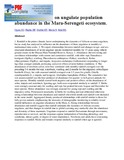| dc.description.abstract | 1. Rainfall is the prime climatic factor underpinning the dynamics of African savanna ungulates, but no study has analysed its influence on the abundance of these ungulates at monthly to multiannual time scales. 2. We report relationships between rainfall and changes in age- and sex-structured abundances of seven ungulate species monitored monthly for 15 years using vehicle ground counts in the Maasai Mara National Reserve, Kenya. 3. Abundance showed strong and curvilinear relationships with current and cumulative rainfall, with older topi, Damaliscus korrigum (Ogilby); warthog, Phacochoerus aethiopicus (Pallas); waterbuck, Kobus ellipsyprimnus (Ogilby); and impala, Aepyceros melampus (Lichtenstein) responding to longer lags than younger animals, portraying carryover effects of prior habitat conditions. 4. The abundances of newborn calves were best correlated with monthly rainfall averaged over the preceding 5-6 months for topi, waterbuck, warthog, and 2 months for the migratory zebra Equus burchelli (Gray), but with seasonal rainfall averaged over 2-5 years for giraffe, Giraffa camelopardalis (L.); impala; and kongoni, Alcelaphus busephalus (Pallas). The cumulative late wet-season rainfall was the best predictor of abundance for quarter- to full-grown animals for most species. Monthly rainfall exerted both negative and positive effects on the abundances of zebra, impala and waterbuck. Ignoring age, both sexes responded similarly to rainfall. 5. Births were strongly seasonal only for warthog and topi, but peaked between August and December for most species. Hence abundance was strongly seasonal for young topi and warthog and the migratory zebra. Pronounced seasonality in births for warthog and topi obliterated otherwise strong relationships between abundance and rainfall when both month and rainfall were included in the same model. Aggregated density produced relationships with rainfall similar to those for fully grown animals, emphasizing the necessity of demographic monitoring to reliably reveal rainfall influences on ungulate abundance in the Mara. 6. Strong relationships between abundance and rainfall suggest that rainfall underpins the dynamics of African savanna ungulates, and that changes in rainfall due to global warming may markedly alter the abundance and diversity of these mammals. Ungulates respond to rainfall fluctuations through movements, reproduction or survival, and the responses appear independent of breeding phenology and synchrony, dietary guild, or degree of water dependence. Newborns and adults have contrasting responses to rainfall. Males and females respond similarly to rainfall when age is ignored. | en |

